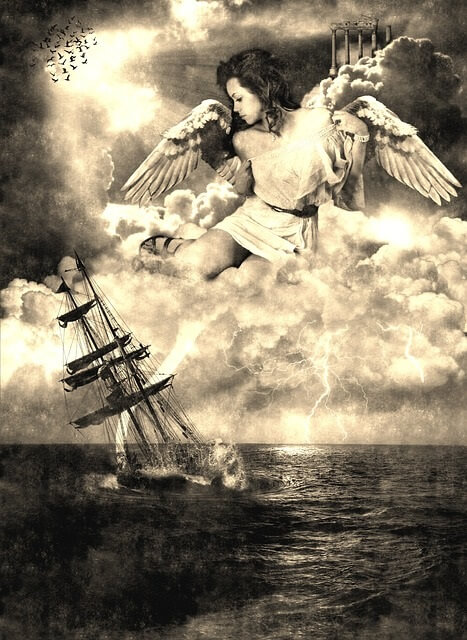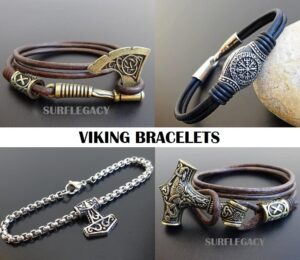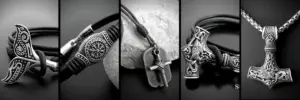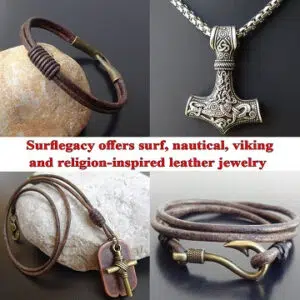In this blog post, we will explore the lesser-known aspects of Norse mythology, focusing on the Norse sea goddess Ran and her connections to other ocean-related deities.
We will delve into the stories, symbolism, and relationships of these powerful figures and their significance in Norse beliefs and traditions.
Join us as we examine the intricate world of Norse sea goddesses and their influence on the ancient Norse people.
Ran the Norse sea goddess
Ran, the Norse sea goddess, is one of the most prominent sea-related deities. She is married to Aegir, a god of the sea and brewing, and together they embody various aspects of the sea’s nature.
Ran is known for her darker and more destructive side, while Aegir is generally portrayed as more benevolent, though he too can be unpredictable.
Ran, is depicted as a fragile-looking woman with a bluish-green complexion. Her lengthy black hair trails on the ground as she strolls through Aegir’s domain, gradually fading into nothingness.
This is due to the magical connection her hair shares with all the seaweed growing in the northern seas. Similar to her daughters, Ran can assume a mermaid-like appearance or take on a humanoid form with legs.
However, she is more inclined to choose the latter, possibly because her role as Aegirheim’s hostess demands her to walk on mother-of-pearl flooring more often than swim.
Ran’s weapon of choice is a net that she uses to drag people to their demise. Scholars have translated her name as “robber,” “ravager,” or “plunderer,” but Alby Stone has suggested that ‘Ran’ originates from the ancient Indo-European term rani, meaning ‘lady.’
Among the etins, female sea-giants are most likely to seduce humans, although succumbing to their advances can be perilous. Ran is responsible for creating all sea-storms in the northern oceans.
Ran embodies the sea’s more menacing and destructive aspects, as opposed to Aegir, who might initially appear friendly but could suddenly turn hostile.
She is stunning, yet her teeth are sharp and her fingers resemble claws. Her smile sends shivers down your spine, or at least it should. Collecting deceased souls to inhabit Aegirheim is her favorite pastime.
While Aegir maintains an “honorary” status among both the Aesir and Vanir, there is no doubt that Ran’s allegiances lie elsewhere. She enjoys a good relationship with Hela, the goddess of death, and prefers the company of the elder deities.
According to an Icelandic saga, drowned individuals appearing at their funeral feasts signified that Ran had welcomed them into her hall.
In Fridhjof’s Saga, possessing gold when lost at sea was considered fortunate. The protagonist even distributed small gold pieces among his crew when they encountered a storm, ensuring they would not arrive empty-handed at Ran’s hall if they drowned.
These souls would feast, party, and sing in Ran’s hall for centuries, but eventually, the unpredictable Sea Queen would grow weary of them and send them to Hela’s domain, Helheim, the land of the dead.
On the flip side, tossing gold overboard and reciting a prayer might appease Ran enough to grant safe passage and smooth sailing.
Those favored by Ran were believed to be fortunate at sea, although this blessing was considered double-edged; if she admired you enough, she would eventually bring you to her side.
An altar dedicated to Ran may feature various sea colors, with a preference for greenish hues. In addition to shells and marine life, she appreciates gold jewelry, symbolic “pirate treasure,” dried seaweed, and miniature toy ships representing the vessels she claims.
The etymology of her name and its various interpretations
The name of Ran, Old Norse: [ˈrɒːn] the Norse sea goddess, has been subject to various interpretations and translations by scholars. The most common translations of her name are “robber,” “ravager,” or “plunderer.”
These interpretations are in line with her role as a destructive and unpredictable force of the sea, dragging sailors down to their deaths with her net.
However, an alternative interpretation of Ran’s name has been proposed by Alby Stone, who suggested that the name ‘Ran’ is derived from the Old Indo-European word rani, which means ‘lady.’
This interpretation highlights her status as a powerful and respected female deity within Norse mythology.
The etymology of Ran’s name, therefore, can be seen as a reflection of her dual nature—both as a destructive force and as a respected female figure among the pantheon of Norse gods and goddesses.
Ran’s Dual Nature: Beauty and Destruction
Ran, possesses a fascinating dual nature that combines both beauty and destruction. Her appearance is enchanting, with delicate features and blue-green skin.
Her long black hair, which magically connects to all the seaweed in the northern seas, trails gracefully behind her. At the same time, Ran’s beauty is deceptive, as she embodies the darker and more treacherous aspects of the sea.
In contrast to her husband, Aegir, who may initially seem friendly but can suddenly turn hostile, Ran makes no secret of her destructive tendencies. She is known to drag sailors to their deaths with her net, her teeth are sharp and pointed, and her fingers are claw-like, hinting at her dangerous nature.
Ran is also responsible for creating all sea-storms in the northern oceans, further emphasizing her destructive power. As the personification of the sea’s darker aspects, she represents the perils and unpredictability that the ancient Norse people faced when navigating the vast and often treacherous waters.
Despite her destructive nature, Ran’s captivating beauty and allure remain a significant aspect of her character. She is often portrayed as a flirtatious siren, seducing humans with her charm. However, succumbing to her advances could lead to disastrous consequences, as her intentions are rarely benevolent.
Ran’s Relationships with Other Deities
Ran, the Norse sea goddess, has relationships with various other deities in the mythological pantheon. Her connections with these gods and goddesses highlight her unique position and emphasize her complex character.
- Aegir: Ran is married to Aegir, the sea giant, and together they rule over the underwater realm of Aegirheim. Aegir is often depicted as more benevolent than Ran, although he can be unpredictable as well. Their union represents the various aspects of the sea, with Ran personifying the darker, more destructive side, and Aegir embodying the calmer and more hospitable elements.
- Hela (Hel): Ran is on good terms with Hela, the goddess of death who presides over the realm of the dead, Helheim. This connection underscores Ran’s association with death and the afterlife, as she collects the souls of drowned sailors and populates her hall in Aegirheim with them. Eventually, when she tires of their presence, she sends these souls to Helheim to join Hela’s domain.
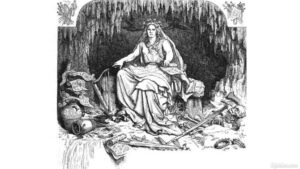
- Aesir and Vanir: While Aegir maintains a unique status as an “honorary” member of both the Aesir and Vanir tribes of gods, Ran’s allegiances are less clear. Her darker nature and alliance with Hela suggest that she might be more closely aligned with the older gods or the Jotnar (giants) rather than the Aesir or Vanir.
- The Billow Maidens: Ran and Aegir have nine daughters, known as the billow maidens or wave maidens. Each of these female deities represents a different aspect of the ocean waves. Although they are not explicitly referred to as sea goddesses, they share a strong connection to the sea and are an extension of their parents’ influence on the ocean.
Ran’s Role in Norse Folklore and Beliefs
Ran’s role in Norse folklore and beliefs is multifaceted, as she embodies various aspects of the sea and its significance in the lives of the Norse people. Some of her roles in Norse folklore and beliefs include:
- Personification of the sea’s darker aspects: Ran is the embodiment of the sea’s destructive nature and its inherent dangers. She is known to cause sea storms and drag sailors to their deaths with her net. Her character reminds the Norse people of the sea’s unpredictability and the ever-present risks they faced while navigating its waters.
- Guardian of drowned souls: In Norse beliefs, Ran collects the souls of those who have drowned and brings them to her underwater hall in Aegirheim. According to some folktales, if drowned individuals appeared at their funeral feasts, it was a sign that Ran had given them a warm welcome into her realm. Her role as a collector of souls highlights the importance of the sea in the Norse understanding of the afterlife.
- Provider of hospitality: Despite her destructive nature, Ran is also known for her hospitality, hosting the drowned souls in her hall for centuries. This aspect of her character emphasizes the dual nature of the sea, as both a place of danger and a source of sustenance and support.
- Influence on seafaring practices: Ran’s role in Norse beliefs also impacted seafaring practices. Sailors would sometimes carry gold or other valuable items with them, hoping that these offerings would appease Ran and ensure their safe passage in case they drowned. Additionally, it was believed that those who enjoyed success and luck at sea were favored by Ran, although this was considered an ambivalent blessing, as she might eventually decide to bring them to her realm.
- Connection with rituals and worship: Ran’s influence extended to rituals and worship practices as well. Altars dedicated to her often featured colors of the sea, particularly green shades, along with shells, dried seaweed, gold jewelry, and small toy ships symbolizing the vessels she claimed.
Ran’s role in Norse folklore and beliefs illustrates the complex relationship between the Norse people and the sea. As a personification of the ocean’s beauty, danger, and mystery, Ran highlights the sea’s essential role in Norse society and the deep respect and fear it inspired among the people who relied on it for their livelihood and survival.
Honoring Ran: Altars and Offerings
To honor Ran, altars and offerings often include elements that represent her connection to the sea and her dual nature as both a beautiful and destructive force. Some of the colors, symbols, and items that represent Ran include:
- Colors of the sea: Altars dedicated to Ran often feature various shades of blue and green, representing the colors of of the ocean. Ran is particularly fond of the greener hues, reflecting her association with the sea’s depths and darker aspects.
- Seaweed: As Ran’s long black hair is magically linked to all the seaweed in the northern oceans, incorporating dried seaweed into an altar or offering is a way to symbolize this connection and honor her influence over the sea.
- Sea life and shells: Incorporating shells and other marine life elements into an altar or offering is another way to celebrate Ran’s domain and her connection to the underwater world.
Incorporating these elements into an altar or offering dedicated to Ran serves to honor her connection to the sea and acknowledge her dual nature as a source of both beauty and destruction.
By paying tribute to her through these symbols and items, worshippers recognize her significance in Norse mythology and her impact on the lives of those who depended on the ocean for their livelihood and survival.
Sisters of the Sea: The Nine Billow Maidens
In the realm of Norse mythology, the billow maidens, also known as the nine maidens, are the nine daughters of the sea goddess Ran and her husband, the sea giant Aegir.
While not explicitly referred to as sea goddesses, these female deities possess a strong connection to the sea and its many facets, complementing their parents’ roles in the mythological pantheon.
Each of the nine sisters represents a different aspect of ocean waves, embodying the varied and dynamic nature of the sea. Their names are often associated with the Old Norse language and, in some cases, directly describe their characteristics. The billow maidens include:
- Himinglæva – “Heaven-Clearing” or “Transparent Sky,” linked to the calm, translucent waves that reflect the sky.
- Dúfa – “Pitching” or “Surging,” associated with large, swelling waves.
- Blódughadda – “Bloody-Haired,” connected to the red hues seen in waves during sunsets or sunrises.
- Hefring – “Lifting” or “Rising,” representing the slow, gentle rise of waves.
- Udr – “Frothing Wave,” symbolizing waves with white, foamy crests.
- Hrönn – “Welling Wave,” indicative of waves that swell and build up in strength.
- Bylgja – “Billow” or “Breaking Wave,” associated with waves that break and crash onto the shore.
- Dröfn – “Foam-Fleck” or “Comber,” connected to the foam and spray created by turbulent waves.
- Kólga – “Cool Wave,” representing the refreshing, cold waves in the northern seas.
The billow maidens not only symbolize the diverse characteristics of ocean waves but also serve as an extension of Ran and Aegir’s influence over the sea.
As daughters of the sea goddess and sea giant, they exemplify the importance of the ocean in Norse mythology and its impact on the lives of the Norse people.
In various legends and sagas, the billow maidens are occasionally depicted as accompanying their father, Aegir, on his voyages, helping him to control the sea and its many moods.
In this capacity, they reinforce the connection between the deities and the sea, emphasizing the intricate relationship between the ancient Norse people and the vast, powerful, and often unpredictable waters that surrounded them.
Norse deities with connections to water or the sea
- Njord: Njord is a significant Norse deity associated with the sea, wind, wealth, and seafaring. As a member of the Vanir, he is closely connected to the natural world, particularly the ocean and its influence on the lives of the Norse people. As the father of Freyr and Freyja, Njord is part of a divine trio that plays a crucial role in Norse mythology, representing various aspects of prosperity, fertility, and natural forces. As the god of the sea, Njord holds sway over the ocean’s vast expanse and its bountiful resources. He is revered as the protector of sailors and fishermen, guiding them through treacherous waters and ensuring safe passage during their maritime endeavors. His domain is the realm of Noatun.
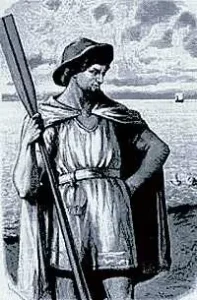
Njord
- Freyr: Freyr is a prominent Norse god associated with rain, sunlight, fertility, life, and summer. As the son of the sea god Njord and the brother of Freyja, Freyr holds a significant place in Norse mythology. He is a member of the Vanir, a group of gods known for their connection to nature, fertility, and wisdom. Freyr governs the growth of crops, the abundance of harvests, and the prosperity of the people. His influence on rain and sunlight directly impacts the fertility of the land, ensuring bountiful harvests and the overall wellbeing of the Norse people. He is often depicted with a powerful sword and rides a boar named Gullinbursti, which symbolizes his connection to fertility and abundance.
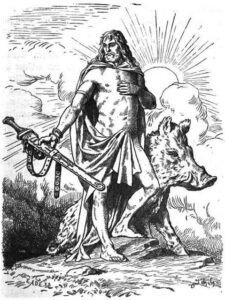
Freyr
- Saga is a lesser-known Norse goddess who was believed to take the form of a waterfall. According to Norse mythology, she was one of the goddesses who lived in the halls of Asgard, home of the gods. Although her name might imply that she was associated with storytelling and sagas, her true nature and attributes are shrouded in mystery.
- Nehalennia is a lesser-known goddess associated with the North Sea. Her worship mainly occurred in the coastal areas of the present-day Netherlands and Belgium. While there is limited information about her specific role in Norse mythology, Nehalennia is often depicted with maritime symbols such as ships and dolphins, which signify her connection to the sea. In some instances, she is portrayed as a protective deity, safeguarding sailors and fishermen during their voyages. Nehalennia’s association with the sea highlights the importance of maritime activities in the lives of ancient peoples inhabiting the North Sea region.
- Nerthus, primarily an earth goddess, is also associated with lakes, springs, and holy waters in Norse mythology. As a deity connected to the natural world, Nerthus represents the fertile soil and the life-giving properties of water. Her influence spans agricultural abundance, the health of the land, and the spiritual connection between humans and the earth. While her primary domain is the earth, her association with bodies of water emphasizes the interconnectedness of various natural elements in Norse beliefs. Lakes, springs, and holy waters under her purview symbolize the essential role of water in sustaining life and maintaining the balance of the natural world.
- Mimir: Mimir is a wise being associated with wisdom and knowledge. He is the guardian of a well called Mimir’s Well, which is located near the roots of the World Tree, Yggdrasil. Mimir’s connection to water comes from this well, as the waters are said to grant wisdom and insight to those who drink from it.
Conclusion
The Norse sea goddess Ran, along with her nine daughters and other deities connected to the ocean, play an essential role in Norse mythology.
Their stories and attributes reflect the deep-rooted respect and awe the ancient Norse people had for the sea, which influenced their lives as sailors, traders, and warriors.
By understanding these sea deities’ complex relationships, symbolism, and significance, we gain valuable insights into the richness and diversity of Norse beliefs and traditions.
The tales of the Norse sea goddesses serve as a testament to the enduring allure of the ocean and its powerful influence on human imagination, culture, and spirituality.
See also:
Rán: Goddess of the Treacherous Seas
Shop Viking Jewelry
Are passionate about Vikings or Norse Mythology?
Finding the ideal piece of Viking Jewelry can be challenging and time-consuming, especially if you lack inspiration or don’t know where to look.
Surflegacy, has you covered. We have a wide range of Handmade Jewelry in various styles, shapes, colors, and materials, to accentuate your Viking spirit and look. Do not hesitate to visit our selection HERE
Whatever you wear, you’ll find the ideal trendy piece to complement your wardrobe. Our jewelry is designed to be worn every day, no matter where you go or what season is. Are you ready to step up your wardrobe game?

